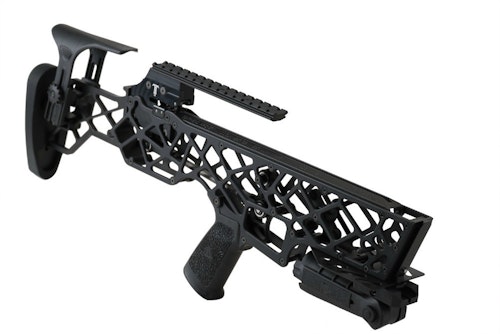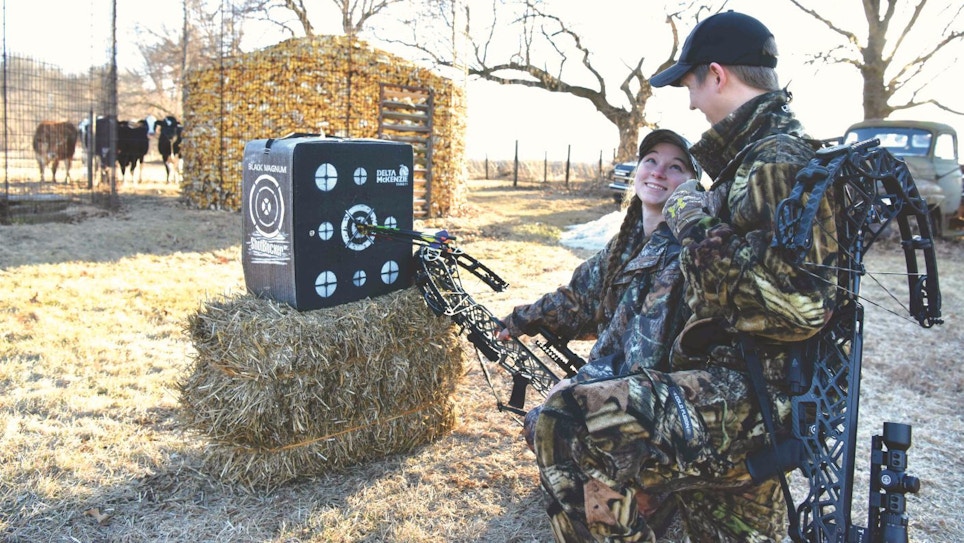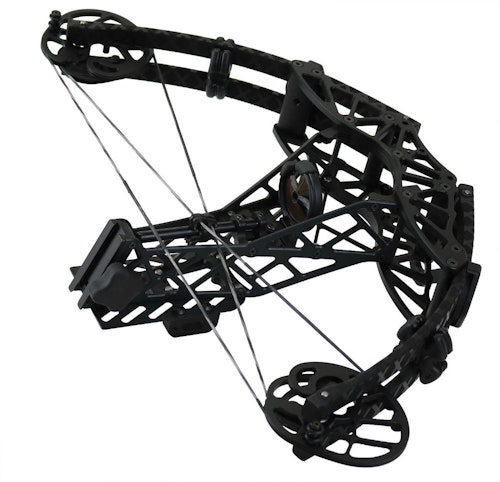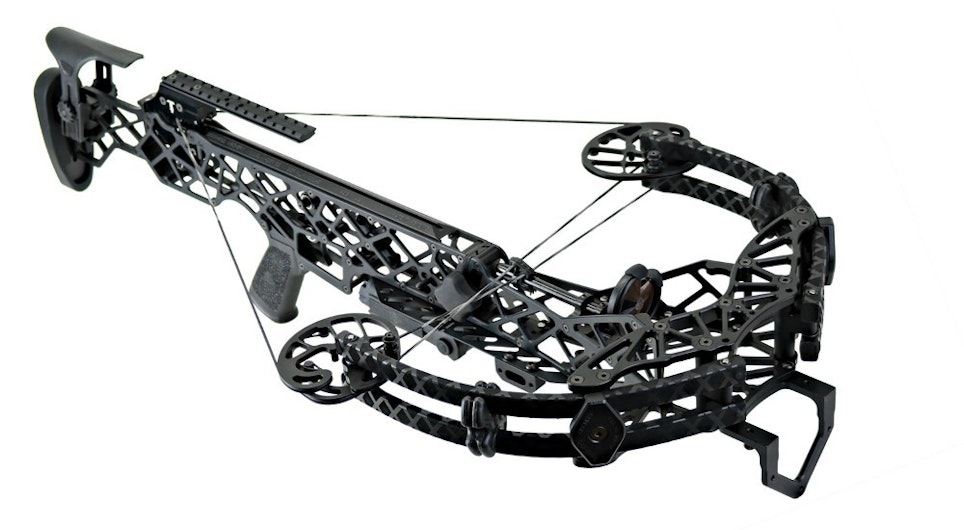Stout and sturdy, using carbon fiber or aluminum framing with an eye-catching “Erector Set” flair, the Gearhead X-16 series of crossbows are made to last a lifetime. This line of crossbows should prove popular with users who have had a composite-stocked crossbow break or crack at the grip during normal use under abnormal conditions. To prove it, I disassembled the X-16 and left it in the freezer overnight and then reassembled and fired it 100 times with no malfunctions or loss of accuracy.
Right out of the box the X-16 will draw cheers from long-time crossbow fans. Assembly takes less than 5 seconds. Simply slide the two dove-tailed halves together (photos below) and tighten the cam clamp into place. No tools are required. It’s fast, easy and ready to shoot, just like that. I spent more time deciding on cheek piece and foregrip adjustments than I did assembling the bow, and in less than 1 minute I was ready for the archery range.

As always, I highly recommend studying the Gearhead owner’s manual for the X-16 series. In addition to the usual safety advice and specifics on how to operate the crossbow’s various adjustable components, it also explains how to use the differing safety switches while cocking and shooting the crossbow.
Also included are reminders that only 400-spine arrows 24 inches in length (with any nock) may be used. Failure to abide by this requirement, or shooting any arrow weighing less than 300 grains, will void the warranty.
The manual features nicely illustrated instructions on how to cock the crossbow by hand or using a cocking rope. Young and healthy shooters should have no trouble hand-loading the 70-pound-pull X-16, but others are best advised to master the use of the cocking rope. No crossbow is designed or intended to be used in fast-draw competitions, so it benefits the user to know how to properly cock and load his X-16 for the one decent shot he’s likely to get on a real-world hunt. Make that first arrow count and you won’t have to worry about hurried follow-up shots.
The X-16 series crossbows do differ to some degree, primarily in color availability, trigger pull and pull weight. The owner’s manual clearly illustrates and discusses those differences so the shooter will be ready for action at the range and in the field.
One major point that experienced crossbow users will notice is that when cocked and loaded, the arrow never actually touches the rail. The point end of the arrow is placed inside the arrow rest and then the nock is pushed firmly into position inside the trigger mechanism with the cock feather facing up. This is completely opposite of most crossbow loading instructions. The arrow must lock firmly into place on the string, otherwise a dry-fire will result. This is another good reason to read and understand every page of the owner’s manual.
To unload the X-16 one must shoot a standard arrow into a soft target or use a “discharge arrow” in its place. Attempting to unload the X-16 by hand or using any other method could damage the crossbow, injure the operator and void the bow’s warranty. Again, read and heed!
Routine maintenance for the X-16 is simple and easy. Gearhead recommends waxing the string, center serving (which holds the nock of the arrow in place) and the power cables after every 25 shots. Also, Gearhead suggests that users thoroughly dry the crossbow and its components after use in wet weather. I use a basic hair dryer set on ‘Low’ to dry my crossbows and arrows after a long day of hunting in rain or snow.
Gearhead also recommends against leaving the crossbow cocked for “extended periods of time” but offers no specifics. For test purposes, I cocked the X-16 first thing in the morning, just as I would during a typical hunting trip, and left it cocked until 30 minutes after sunset. The bow performed flawlessly and all shots were dead-on out to 40 yards. I believe that if users shoot their X-16s at the end of every hunting day, they’ll meet or exceed the manufacturer’s “extended period” cautionary note.
The provided Hawke scope is illuminated in red and green for better definition under various weather conditions, and it is calibrated in five intervals at 10 yards per reticle. Starting with the top reticle at 20 yards and making the necessary adjustments for arrow speed (350 fps in the case of the X-16 with 125-pound pull), I was on target and ready for the roving range by the third shot.
I like to fire at least 100 arrows from the bench just to test a crossbow’s function and reliability, and in this case I alternated between the cocking rope and my bare hands. The X-16 is definitely easy to cock with bare hands (all early crossbows had to be similarly man-handled in order to cock them), but there’s a reason rope-cockers were invented. I’d stick with one just for the sake of continuity and consistency. A rope cocker will give users better control over the string and be considerably easier on the fingertips, especially when firing 50, 100 or more shots in one session.
With all this in mind it was off to the range for sighting in and function testing. Considering that the X-16 requires only 75 pounds of effort to cock the crossbow, I decided to alternate between manpower and the cocking rope techniques. Granted, cocking the crossbow by hand was faster overall, but the cocking rope allowed me a little more time to relax and regroup between shots. I suspect that the additional effort and stress of loading manually might affect a shooter during extended range competition, but for hunters, who are likely to shoot once per day or even once per week, the difference is moot.
Once I had the X-16 on target at 20 yards, I kept up a steady pace of cocking, loading and shooting at random distances from 20, 30 and 40 yards, which are as far as I care to shoot during most real-world whitetail situations. I did shoot a few test arrows at 50 and 60 yards just to test the calibration of the scope and was never more than 1 inch off point of aim, even at the longer distances. The scope is calibrated for shooting out to 100 yards, but I found that my groups expanded considerably past 60 yards. At maximum range my arrows were striking well inside an 8-inch circle, certainly good enough for deer at that distance, but where I hunt I can easily halve the distance by simply waiting for a closer shot and prefer to do so. There are a variety of logical, sensible reasons to avoid shooting an arrow at a live deer at 100 yards, although it can be done. My decades of field experience caution against it, and I tend to listen to the voices in my head.
With the X-16 sighted in and hitting dead-on at all practical distances, it was time to head for the roving range, which includes a variety of block and silhouette targets set at random distances off a winding, twisting logging trail in typical Northeast whitetail habitat. In fact, there are deer tracks leading right up to most of my targets, so I can say that my setup is as realistic as one can get for practice purposes.
I immediately lamented the lack of a sling in the X-16’s basic package. While the crossbow is lightweight and nicely balanced, it is still a crossbow and, by design, is just awkward and clunky enough to demand a sling for carrying and shooting. I jury-rigged a standard sling to the crossbow and made do, but any strap or even a piece of half-inch nylon rope can be tied to the unit with a bit of creative weaving.
On the range, the X-16 was pleasant to carry and downright deadly accurate at all stations. I try to make my target encounters as realistic as possible by looking away and then telling myself, “There’s one!” and shooting as quickly as possible from a port arms position. The X-16 came up quickly and was on target at every setting from 1.5X to 5X. To duplicate normal still-hunting conditions I set the scope on 3X, but when shooting from blinds and stands I set it at 5X, just as I would under real hunting conditions.
While on the roving range, I alternated between 10- and 40-yard shots at random just to add additional reality to the situation. It was spring with few leaves on the trees at press time, but there were plenty of shadows created by passing clouds and larger trees to make visibility a bit of an issue.
Overall the X-16 performed perfectly both mechanically and ballistically — loading was quick and easy manually or with a cocking rope and all hits were in the kill zone. One can’t ask for much more from a hunting-level crossbow. However, at an MSRP of $1,699, I would not expect anything less.
My only complaint about the X-16 is that it has no provision for a sling, not even factory-installed swivels, to expedite the process. However, the unique design of the unit allows for easy attachment of an accessory sling by simply looping the straps through the metal frame at comfortable intervals. In a pinch, a spare pack strap or even a length of rope can be used effectively.
The X-16 base model package includes the crossbow, quiver, three arrows, cocking rope and a custom fitted case. MSRP is $1,699 in aluminum or $2,199 in carbon fiber.
For more information on Gearhead’s complete line of hunting bows and crossbows, visit www.gearheadarchery.com.
Gearhead X-16 Specs
- Draw weight: 75 pounds
- Power stroke: 16 inches
- Arrow length: 24 inches
- Arrow speed: 350 fps
- Trigger pull: 3.1 pounds; dry-fire inhibitor
- Sights: Hawke multi-reticle illuminated scope provided, factory mounted
- Cocking device: Cocking rope provided; hand cocking optional
- Overall length: 35.5 inches
- Axle-to-axle width: 14.75 inches cocked, 18.5 inches uncocked
- Weight: 4.5 (carbon) to 6.2 pounds
- Other features: The X-16 series includes the X-16, Tactical and Target versions in carbon fiber, Desert Tan or Predator Custom Dip and Earthtone colors; uses standard-nock arrows; unique dove-tail assembly; breaks down for transport or storage; adjustable cheek piece and five-position foregrip. Tactical and Pro versions feature 2.1-pound trigger pull.
- MSRP: $1,699 (aluminum frame), $2,199 (Carbon frame)
Sidebar: A Case That Matters
Gearhead’s new X-16 series of crossbows are shipped with a custom-fitted field pack that makes storing and transporting the unit a truly enjoyable experience. Disassembled and packed for shipment, the case measures 14x24 inches and is about 10 inches deep. The crossbow fits into a customized foam container that nestles into its own large, deep pocket within the pack.
There are several zippered pockets inside and outside the pack that can carry all manner of accessories, tools and necessaries ranging from string wax to slings, broadheads, scope covers and arrows. No need for separate kits and cases with the X-16. The fitted case is made to safely protect the crossbow on the way to any destination, in addition to providing sufficient space for all the range and field gear one could possibly use at the bench or in a blind or stand.
For ease of transport, the complete kit is smaller and more compact than the average airline carry-on.









